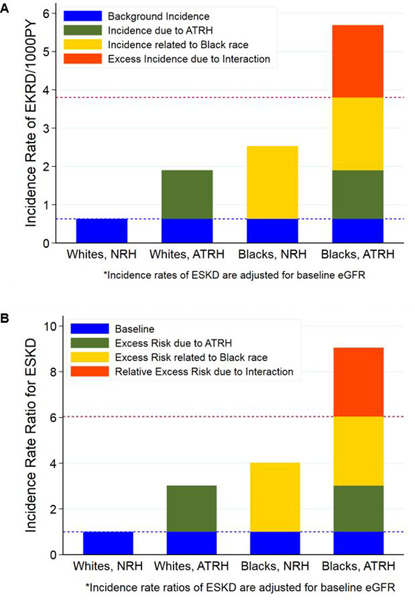Figure 2.
A. Excess incidence of incident ESKD due to interaction between ATRH and race. In the absence of interaction, the expected incidence rate (per 1000PY) among blacks with ATRH would be the sum of the background incidence (0.63), incidence due to ATRH alone (1.27) and incidence related to black race (1.90). However, the observed incidence (5.69) was greater than the expected (3.80); which is suggestive of synergistic additive interaction between ATRH and black race for the association with incident ESKD. The excess incidence due to interaction (dark orange bar) represents an excess of 189 incident ESKD cases per 100, 000PY among blacks with ATRH. Abbreviations: ATRH, apparent treatment resistant hypertension; ESKD, end-stage kidney disease; NRH, non-resistant hypertension; PY, person-years.
B. Relative excess risk of incident ESKD due to interaction between ATRH and race. The Y-axis represents the incidence rate ratio (IRR) for ESKD comparing whites with ATRH, blacks with NRH, blacks with ATRH to the referent group (whites with NRH). The relative excess risk due to interaction (RERI) between ATRH and race = IRR11 - IRR10 - IRR01 + 1 = 3.00 (95%CI: 1.79, 4.21); and is represented by the dark orange bar as in Figure 2A. The attributable proportion (AP) = RERI/IRR11 = 33.2 (95%CI: 23.6, 42.7) suggesting that 33.2% of the risk of incident ESKD among blacks with ATRH is due to the synergistic interaction between ATRH and race. Abbreviations: ATRH, apparent treatment resistant hypertension; ESKD, end-stage kidney disease; NRH, non-resistant hypertension.

